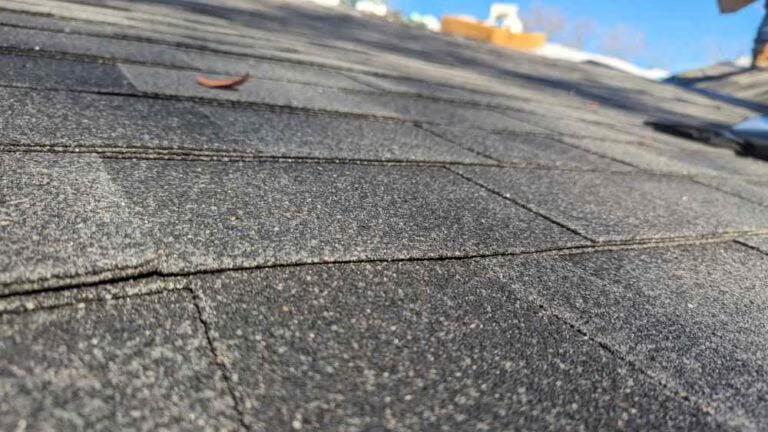To estimate how much roofing material you need, start by determining the total square footage of your roof. Consider the pitch of the roof—it affects material coverage and quantity. For shingles, understand that different products cover different areas; consult the manufacturer's details for accuracy. Remember to account for features like dormers and skylights that may require additional material. Also, factor in a waste percentage to accommodate cutting and fitting, traditionally around 10-15%. Precision tools and roofing software can greatly aid in obtaining accurate measurements. By understanding these elements, you are well equipped to make informed choices about your roofing needs.
Key Takeaways
- Measure the total square footage of your roof, including irregular areas like dormers.
- Determine the pitch of your roof to adjust material quantities accordingly.
- Consult manufacturer specifications for coverage per bundle of shingles or square footage of other materials.
- Estimate additional material by adding 10-15% to account for waste and cutting errors.
- Include essential materials like flashing and underlayment in your calculations for comprehensive coverage.
Understanding Roof Measurements
Accurately measuring a roof is crucial for determining the quantity of materials needed and guaranteeing proper project planning. One of the fundamental aspects of this measurement is understanding the roof pitch, which is the incline of the roof expressed as a ratio of its vertical rise to the horizontal run. This measurement is pivotal because it influences the amount of roofing material required and affects how roofing bundles are calculated and deployed.
Roof pitch can vary significantly, from shallow slopes to steep peaks, and each requires a different approach to material estimation. A steeper roof pitch means a larger surface area than what might be apparent from ground level or basic floor plan dimensions. As a result, calculating the pitch correctly ensures that you neither underestimate nor overestimate the material needs.
Regarding roofing bundles, it is essential to recognize that these are pre-packaged amounts of shingles covering a specific area when laid out. Typically, three bundles amount to a square, which covers 100 square feet. However, due to the increased surface area created by higher pitches, additional bundles might be necessary to account for the extra coverage needed, guaranteeing complete roof coverage and efficient material utilization.
Calculating Roof Square Footage
To calculate the square footage of a roof, one must first determine the total area of each roof plane and then sum these areas to obtain the overall roof coverage. Begin by measuring the length and width of each plane. Multiply these figures to get the area in square feet for each section. It's important to include dormers, extensions, and any other irregularities in your calculations to guarantee accuracy.
Next, add all these individual areas together. This total gives you the square footage necessary for purchasing the right amount of roofing material. Keep in mind that knowing this figure not only helps in estimating roofing material cost but also aids in planning if you're considering a DIY installation.
When engaging in DIY installation, precise measurements are crucial. Incorrect measurements can lead to purchasing insufficient material, thereby increasing costs and potentially delaying your project. Utilize a detailed diagram of your roof layout to assist in re-checking measurements and planning material cuts effectively. This foresight will save you time and resources, emphasizing the importance of accuracy in initial calculations. Remember, an error in measurement translates directly to cost and labor inefficiencies, so take your time to do it right.
Types of Roofing Materials
Having calculated the total square footage of your roof, you can now explore the various types of roofing materials available, each offering distinct advantages and various aspects to take into account. When selecting a roofing material, two critical factors to contemplate are the costs involved and the durability of the material.
Asphalt shingles are popular due to their cost-effectiveness and reasonable durability, typically lasting between 15 to 30 years depending on the quality. Metal roofing, although more expensive initially, offers enhanced durability, with lifespans ranging from 40 to 70 years, and can withstand harsh weather conditions better than most materials.
For those seeking an eco-friendly option, solar tiles integrate seamlessly with traditional shingles and, while costly, they provide the added benefit of reducing energy bills. Slate roofing is another durable choice, with a lifespan of over 100 years, but it comes with high material and installation costs due to its weight and the skill required for installation.
Each material's cost must be weighed against its expected lifespan and maintenance needs. Investing in a more durable material might lead to higher upfront costs but can prove more economical in the long run due to fewer replacements and repairs. Always take into consideration local climate and your home's structural capabilities when choosing your roofing material.
Estimating Shingles Needed
Estimating the number of shingles needed involves calculating the total roof area and understanding the coverage provided by each bundle of shingles. To accurately determine how many shingles you'll need, first measure the length and width of each roof section and multiply these to get the square footage. Different shingle products cover different areas per bundle, typically ranging from 25 to 33.3 square feet. It's essential to consult the specific coverage details provided by manufacturers to ensure precision.
When choosing shingles, consider these key points:
- *Freedom of Choice:* Embrace your freedom to select from a variety of shingle types and colors that not only meet your functional needs but also express your personal style.
- *Cost Efficiency:* Be mindful of roofing material costs. Selecting the right shingles can lead to long-term savings on repairs and replacements.
- *Reliable Suppliers:* Partner with reputable roofing material suppliers who provide quality products and can offer valuable guidance throughout your purchasing process.
Factors Affecting Material Quantities
Understanding the factors that affect material quantities is essential for accurate roofing project planning and execution. Several variables influence the amount of materials needed, and overlooking any of these can lead to costly adjustments or shortages during the project.
One significant factor is material thickness considerations. Different roofing materials vary not only in weight but also in coverage efficiency due to their thickness. Thicker materials often provide better durability and insulation but require precise calculation to guarantee adequate coverage without excess.
Roofing material costs also play a vital role. Budget constraints can impact the choice of materials and their quality. It's crucial to balance cost with performance needs, considering long-term durability versus initial expenditure.
Here's a summary table that highlights key factors:
| Factor | Impact on Quantity | Consideration |
|---|---|---|
| Material Thickness | Higher thickness increases material demand | Ensure calculations consider specific product specs |
| Material Costs | Budget constraints limit options | Choose the best balance of cost and quality |
| Roof Shape | Complex shapes increase waste | Plan layouts to minimize cuts and waste |
Incorporating these factors into your planning will help achieve a balance between cost-efficiency and performance, guaranteeing a successful project outcome with minimal waste and optimal resource utilization.
Measuring Roof Slope
Measuring roof slope is a critical step in ensuring that roofing materials function effectively and that water drainage is optimized. The accuracy of the roof pitch and the precision of slope calculations are pivotal for achieving peak performance and longevity of your roof. By determining the correct slope, homeowners can feel confident in the resilience and efficiency of their roofing system against environmental challenges.
To measure the roof slope, you must access the roof safely and use tools like a level and a tape measure. Here's how it is done:
- Place a 12-inch level horizontally on the roof surface.
- At the 12-inch mark on the level, measure vertically to the roof's surface. This measurement in inches is the rise over a 12-inch run, indicating the roof slope.
Understanding this measurement allows for:
- Freedom in choosing materials: Select roofing materials that are most suitable for your roof's specific slope.
- Confidence in durability: Know that your roof can withstand weather extremes with proper slope-specific installation.
- Control over costs: Prevent over-purchasing materials by accurately calculating needed quantities based on slope.
This knowledge empowers you to make informed decisions, enhancing both the function and economics of your roofing project.
Accounting for Roof Features
When calculating roofing materials, it is important to accurately measure the area of dormers and skylights, which can greatly influence the amount of required shingles and underlayment. Additionally, the area around the chimney must be carefully assessed to determine the necessary square footage for flashing, which is vital for preventing water intrusion. These features often require unique fittings and additional labor, highlighting the need for precise measurements and planning in the early stages of roofing projects.
Measuring Dormers and Skylights
Accurately calculating roofing materials demands accounting for special features such as dormers and skylights, which impact both surface area and material requirements. When dealing with dormer windows, precise measurements are crucial to guarantee that the additional roofing material compensates for the increased surface area. Similarly, when incorporating a skylight, material estimation becomes vital, as the need for specific types of materials, such as flashing and sealants, increases to maintain waterproof integrity.
To accurately measure and calculate these features, consider the following steps:
- Dormer windows: Measure both the base and the sides of each dormer. Include these areas in your total roof surface calculation. Remember, dormers not only add complexity but also aesthetic value, expanding your freedom in design choices as wide as the skies.
- Skylight dimensions: Note the length and width of each skylight. Calculate the additional materials needed to frame and seal around the skylight, ensuring a leak-free installation.
- Material compatibility: Guarantee that the materials used for dormers and skylights are compatible with the rest of the roof. This comprehensive approach prevents future issues and maintains the roof's integrity.
These detailed considerations will guide you in a precise and effective roofing project, ensuring every feature is perfectly covered.
Calculating Chimney Flashing Area
Proper calculation of the chimney flashing area is fundamental to guarantee a waterproof seal at the intersection of the chimney and roof. Accurately measuring the chimney height and evaluating the roof pitch are vital first steps. The height determines the extent of the flashing needed above the roofline, while the pitch influences how the flashing will contour to the roof.
Selecting the right flashing material is as important as the measurements. Materials like aluminum, copper, or steel each offer different durability and compatibility with various roofing materials. Experienced roofers recommend matching the flashing material with the existing roof to ensure longevity and aesthetic coherence.
For the flashing installation, precision is key. Begin by measuring the base of the chimney and then calculate the additional length required to cover the slope created by the roof pitch. Typically, add an extra 10-15 centimeters to each side of the chimney measurement to allow for adequate coverage. Secure the flashing firmly to prevent any water penetration, using appropriate sealants and fasteners designed for the chosen material and roof type.
Waste Material Considerations
When calculating roofing materials, it is important to accurately estimate waste factors to prevent both excess cost and material shortage. Different types of roof waste stem from cutting, packaging, and accidental damage, each affecting overall project efficiency. Implementing strategies to minimize waste can lead to significant savings, optimizing both resource allocation and environmental impact.
Estimating Waste Factors
Estimating waste factors is important for minimizing unnecessary expenses and guaranteeing efficient use of materials in roofing projects. Accurately determining these factors not only guards against the overestimation risks which can inflate project costs needlessly but also helps in avoiding underestimation consequences that could lead to delays and further expenditures when additional materials are required.
Calculating material needs with precision allows for a balanced approach—ensuring that there is enough material to cover the scope of the project plus an adequate buffer for waste, without veering into excessive surplus. This balance is vital in roofing where both overage and shortage impact project timelines and budget significantly.
Consider these emotional impacts that misestimating can trigger:
- Frustration: when the project stalls because the materials run short, causing unexpected delays.
- Anxiety: over the potential increase in costs due to rush orders or purchasing additional materials last minute.
- Disappointment: in seeing valuable resources wasted if materials are over-purchased.
To navigate these challenges, it's important to engage with experienced professionals who can provide insights into typical waste factors for specific roofing materials and styles. This expertise guarantees that freedom from unnecessary financial and emotional burdens is achievable, maintaining the joy and satisfaction in seeing a roofing project successfully completed.
Types of Roof Waste
Understanding the different types of roof waste is essential for effective material management and cost control in roofing projects. Roof waste mainly consists of unused shingles, damaged materials, packaging, and old roofing removed during renovation. Each type of waste requires specific consideration for disposal or reuse to optimize resources and minimize environmental impact.
Roof waste disposal must adhere to local regulations that often encourage or mandate recycling options. Asphalt shingles, the most common roofing material, can be recycled into road paving and patching materials, offering a sustainable disposal path. Metal, tile, and wood from roofs can also be processed through specialized recycling facilities, ensuring these materials find new life in other construction projects or goods, reducing landfill use and supporting industry sustainability.
Reusing excess materials for DIY projects is not only cost-effective but also environmentally friendly. Excess shingles can be creatively repurposed for projects like building birdhouses, creating art, or enhancing garden paths. This practice not only clears your space of potential waste but also sparks innovation and personal satisfaction in crafting useful items from what would otherwise be discarded. Managing roof waste through strategic disposal and inventive reuse aligns with a commitment to resource conservation and financial prudence.
Minimizing Waste Tips
To effectively minimize roofing waste, contractors should carefully plan material usage and consider the lifespan and recyclability of chosen materials. Emphasizing waste reduction and material efficiency not only aligns with environmental stewardship but also reduces costs, making it a strategic element in roofing projects. Accurate measurement and precise cutting are foundational practices that enhance material efficiency, ensuring that every piece of material serves a purpose and nothing is unnecessarily discarded.
- Opt for Durable Materials: Choosing materials with a longer lifespan reduces the frequency of replacements and the associated waste. Materials like metal roofing, although initially more expensive, can last decades longer than traditional shingles.
- Implement Advanced Planning Software: Utilizing software for precise planning and layout can drastically cut down on over-ordering and excess off-cuts. This technology allows for adjustments before the material is even ordered, optimizing the use of every square foot.
- Recycle Old Materials: Encourage the practice of recycling old roofing materials wherever possible. Many old shingles and metals can be repurposed, notably lowering the impact on landfills and promoting a cycle of sustainability.
These practices not only conserve resources but empower you with the freedom to build responsibly, ensuring your project aligns with both your budgetary and environmental goals.
Tools for Accurate Measurement
Accurate roofing measurements hinge on the use of specialized tools, such as laser distance meters and digital measuring wheels. Embracing digital technology enhances measurement accuracy, essential for both reducing waste and making sure you purchase only the necessary materials. Advanced software integrates with these tools, streamlining the material estimation process, thereby providing not just precision but also significant savings in time and resources.
Using these tools, you can swiftly capture the dimensions of any roofing area, translating data into actionable insights with an unparalleled level of accuracy. This guarantees that every square foot of material is accounted for, directly impacting overall project efficiency.
| Tool Type | Emotional Benefit |
|---|---|
| Laser Distance Meter | Confidence in precise measurements |
| Digital Measuring Wheel | Freedom from manual errors |
| Roofing Software | Peace of mind in material estimation |
| Calculator | Assurance in budget management |
For professionals and DIY enthusiasts who value their freedom, these tools not only offer liberation from the constraints of traditional measuring methods but also empower users to execute their projects with a higher degree of autonomy and expertise. This approach minimizes reliance on external sources, placing control back into your hands.
Tips for Ordering Materials
When ordering roofing materials, it is crucial to take into account not only the square footage but also the specific type of materials and their compatibility with your project's environmental conditions. The selection of the right materials and thoughtful planning of their delivery and storage can greatly influence the efficiency and success of your roofing project. Here are key considerations to keep in mind:
- Material Storage: Choose a supplier who offers sound advice on how to store materials safely until they are needed. Improper storage can lead to material degradation and increased project costs.
- Delivery Options: Opt for suppliers that provide flexible delivery schedules. This ensures materials arrive exactly when needed, keeping your project on track and reducing the need for onsite storage.
- Order Extra: Always order a bit more material than calculated. This accounts for potential miscalculations and wastage, giving you the flexibility to handle unexpected challenges during the project.
Frequently Asked Questions
Can Solar Panels Be Installed on All Types of Roofing Materials?
Solar panel compatibility varies; not all roofing materials support installation due to differing aesthetics and structural requirements. Thorough maintenance and adherence to technical specifications are essential for best performance and longevity.
How Does Weather Impact Roof Material Longevity?
Climate effects and temperature variations critically impact roof material longevity. Regular roof maintenance enhances durability, safeguarding against harsh weather conditions. Understanding these factors offers the freedom to choose materials that best suit specific environmental demands.
Are Eco-Friendly Roofing Materials More Expensive?
Eco-friendly roofing materials often have a higher initial cost compared to traditional options. However, their durability and lower environmental impact can lead to long-term savings and less frequent replacement needs.
What Is the Average Lifespan of a Metal Roof?
A metal roof, with proper maintenance, stands the test of time, boasting an average lifespan of 40-70 years. Regular upkeep and adhering to metal roof warranties can greatly extend this duration.
Can I Mix Different Types of Roofing Materials on One Roof?
Mixing different roofing materials can be feasible, but it requires careful consideration of aesthetics, compatibility, and maintenance. Guarantee both materials align in regard to durability and function to preserve structural integrity and appearance.
Calculating Roofing Material Needs
To sum up, the precise estimation of roofing materials is crucial for both functionality and economic efficiency. Such accuracy guarantees not only the structural integrity of the roof but also the prevention of unnecessary financial expenditure. Utilizing tools like digital measurement applications and following guidelines for extra waste can greatly improve this accuracy. Therefore, meticulous planning, supported by technological aids and informed calculations, stands as the cornerstone of successful roofing projects.






